Simon Phillips on Jeff Beck, Toto and Protocol II
The Toto and session legend takes stock
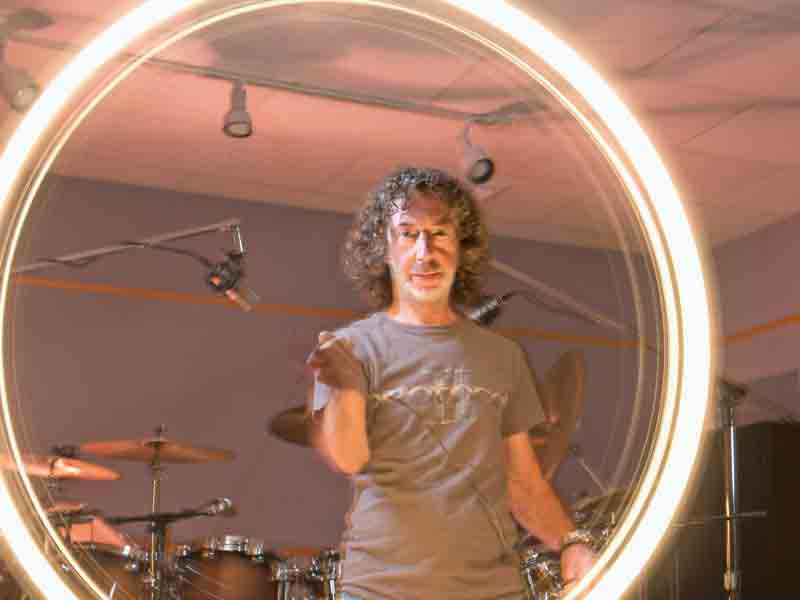
Beginnings and credentials
Simon Phillips greets us on the phone from his home in LA with a cheery, “We’re just back from Europe last week. We did a six week run with The Trio Project, (pianist) Hiromi and (bassist) Anthony Jackson in Canada, the Blue Note in New York and all over Europe. I’m now enjoying really hot weather in LA and mixing a record.”
Simon is a polymath – not content with being one hell of a drummer, he is also composer, band leader, studio owner, engineer and producer.
As a kid he played in his father Sid Phillips’ Dixieland jazz band from the age of 12, famously took over the drum chair in Jesus Christ Superstar at 16, and while still a teenager stormed the London session scene. He was soon to be seen and heard on everything from rock to jazz-fusion to movies. There were any number of 1970s-1980s pop dates.
The list fills pages, so here’s a sample: Toyah, Lyndsey De Paul, Bonnie Tyler, Tears For Fears, Heaven 17, Human League, Madness, 10cc, Nik Kershaw, Judie Tzuke. Then there were the rockier dates with Judas Priest, Mick Jagger, Peter Gabriel, Roxy Music, David Coverdale, Michael Schenker, Mike Rutherford, Robert Palmer, Pete Townshend and The Who.
For movies count Odessa File, Lion King and Pirates Of The Caribbean. But as a virtuoso drumming talent Simon ached to play jazz-rock fusion at the limits of his ability and he gravitated to Jack Bruce, Jeff Beck and Ray Russell.
It was working with Beck that introduced him to US bass god Stanley Clarke, his passport to the US fusion scene. Later he’d appear with heavyweights like Al DiMeola, Frank Zappa and Joe Satriani.
In 1992 Simon was the surprise replacement for the tragic Jeff Porcaro in legendary LA supergroup Toto. Then last year, after 21 years, Simon felt it was time to move on as his career took yet another twist. His long-term friendship with Clarke led to his introduction to the Japanese pianist, Hiromi Uehara. Hiromi is undoubtedly one of the brightest music stars in the world today – an absurdly talented pianist with a seemingly endless store of ideas and the energy and the technique to pull off anything.
There is so much to Simon’s career thus far that we can only touch on some of the major achievements
Check the videos and you see that even the greatest musicians – Phillips and bassist Anthony Jackson (not to mention Simon’s recent dep, the faultless Steve Smith) – take on that look of awe and total concentration, the requirement to keep up with Hiromi. It’s a gig that does justice to Simon’s immense talent and experience and it occurs to Rhythm that Simon is playing better than ever, if such a thing is possible. And with his first solo album since 2007’s Vantage Point to promote and tour (Protocol II, released 25 years after his debut album, Protocol I) now is the time to honour this unique Brit musician.
There is so much to Simon’s career thus far that we can only touch on some of the major achievements and perhaps glean some pointers from the man himself on how he has negotiated such a star-studded course. His CV is staggering, but let’s start by looking at Simon’s new album and how it came about.
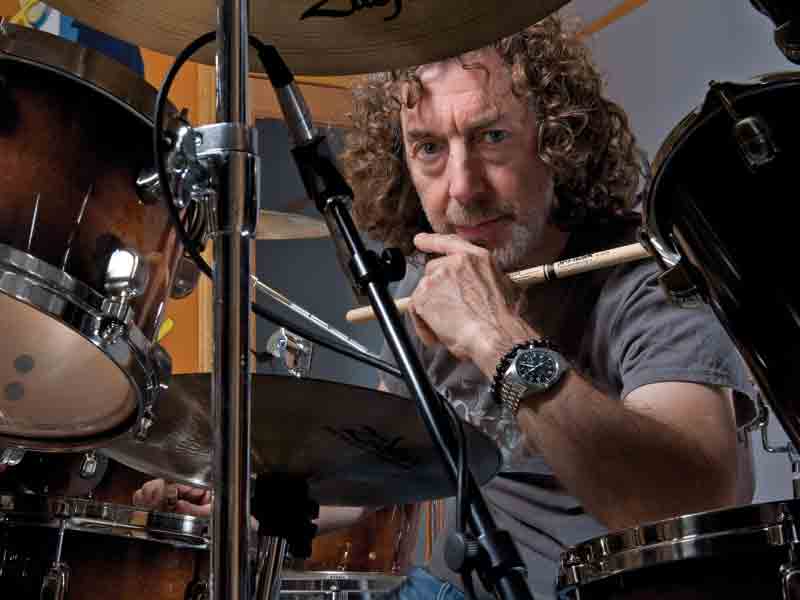
A new chapter
“It was coming to the end of 2012 and I was still in Toto,” Simon begins. “We had a few things – another European tour and maybe some US dates, but it was not occupying a lot of time.
"Hiromi had decided that she was going to do the Night Of The Proms run, really the last three months of 2013,so I was thinking I would really like to do something with my band again. I knew who I wanted to take out on tour and then I thought we should have a CD to sell on the shows.”
Based in LA and with the winter NAMM show imminent, Simon contacted his favourite guitarist Andy Timmons to see if he’d stay over following the show. After a resounding yes, Simon next approached keyboardist Steve Weingart whose last two CDs he’d worked on. Weingart suggested bass player Ernest Tibbs.
Simon continues, “I thought, I have a studio [Phantom Recordings] and some great musicians, we should be able to knock something out, very jam-band like. Which is unlike my other albums, which have all been written, demo’ed and charted out. This was very loose.”
Having fixed the band the next problem was material. “I put together all the demos I had from the last 10 or 14 years. I thought, they’re okay, not great, but I sent them out saying here’s a starting point if you think we can use any bits. And much to my surprise everyone wrote back saying it’s great.”
Thus fortified, Simon took the band into his studio, straight after Winter NAMM. “I got everyone’s sound and we started playing, did it pretty much in five days and played like we were on stage. We tackled most of the stuff from the demos, we did a lot of arrangement changes and I encouraged the guys to co-write.
“When you work on your own material there is always a vulnerability – and that is what makes or breaks it in some ways. Maybe I was too critical or too close to it.
"The toughest thing is when you are doing your own project, because of insecurity, you can be too over-controlling. I was the drummer and the engineer and I put all my concentration into getting everyone’s sound right for the track and then letting the guys do it and just overseeing it. It was exhilarating.
"The toughest thing is when you are doing your own project, because of insecurity, you can be too over-controlling"
"I guess l looked at it more like a band album than a solo album. I took a back seat, which is kind of my method of production anyway. I’ve never been a ‘Führer’, never been that kind of producer. I’m much more loose and jazz, I see what is going on, let it do its natural thing and just be a guide.
"If I see someone going down the wrong path then I’ll steer it back: guys we’re losing focus here. But for me, a more hands-off approach works. Let the talent in the room do their job.”
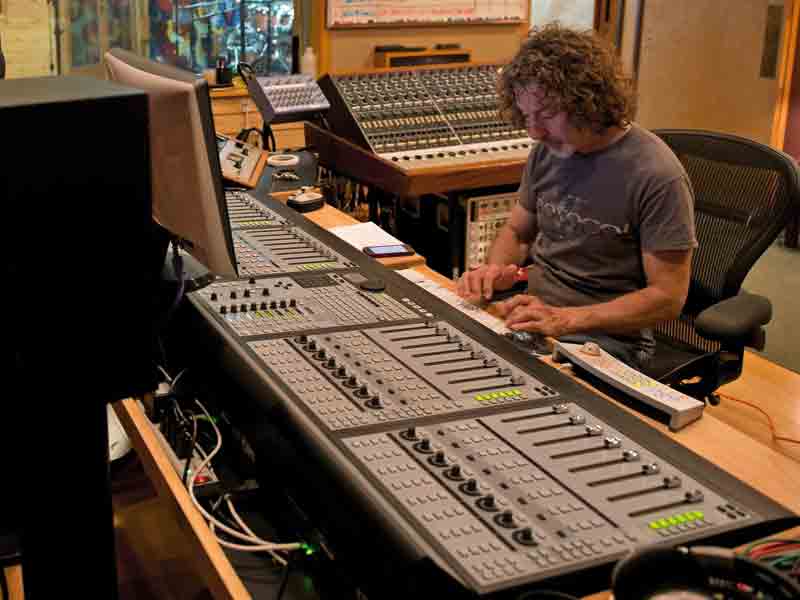
Breaking through
Simon’s experience as engineer and producer goes right back to the 1980s and Mike Oldfield, just one of the many extraordinary and extraordinarily diverse musicians that Simon has formed major collaborations with over the decades.
“Crises (1983) was a hugely successful album, one of the first I engineered and co-produced on.” The memorable, folk-pop ‘Moonlight Shadow’ (1983) was a big international hit. Like many by this time, Oldfield recognised Simon’s bravura talent and gave him leeway to play amazing drums on record and stage. There is mind-blowing yet mature orchestral playing from a youthful Simon over the Fairlight ostinato on the live shows of Crises that you can find on YouTube.
Simon had already proved himself to be a major talent and by the late 1970s he was in tremendous demand by musicians of all genres. One early breakthrough had been the cult 801 Live album (1976) with Phil Manzanera and Brian Eno (taking a break from Roxy Music). “In 1975 and 1976 I played on a lot of records. For 801 Live we only did three shows, but it was groundbreaking at the time. It’s a kind of style where I could be free to really play within a rock context.”
Britain’s greatest rock guitarist, Jeff Beck, soon came knocking
Britain’s greatest rock guitarist, Jeff Beck, soon came knocking. There And Back (1980) cemented Simon’s position as the UK’s most exciting drummer. ‘Space Boogie’, with its prominent double bass drum groove, thrills and challenges drummers to this day. “We started to record in 1978 with Jan Hammer’s material and it became apparent to me that Jeff needed more material – he is not a composer.
"So when I brought [keyboardist] Tony Hymas into the plan I said to Tony, you and I need to write some music. And that is when we came up with ‘The Pump’, ‘Space Boogie’, ‘El Becko’, ‘The Golden Road’ and a bunch of others we never got around to recording because we had to finish the record. Working with [Mahavishnu/Cobham producer-engineer] Ken Scott was wonderful. So that was a major milestone in my career.”
And it was Jeff Beck who paved the way for Simon to conquer America. “I really wanted to move to the States and play in an American band. Unfortunately, I never saw the Mahavishnu Orchestra, but I did see Billy with his band, and Return To Forever.
"I was an absolute disciple of that music, I wanted to be over there with those guys playing it. That was my big dream and all of a sudden in 1978 it came true. I’d started to play with Jeff and he got Stanley Clarke involved and there was that first tour with Jeff and Stanley and then Stanley invited me over to LA to play with his band. Rocks, Pebbles And Sand [Stanley Clarke, 1980] brought me to a much more American audience.”
Simon’s drumming was developing in leaps and bounds. “I’m a huge fan of Lenny [White, Return To Forever] and very heavily influenced by Billy Cobham. Billy and Lenny influenced me to change over [to left hand lead/open-handed playing]. I blame both of them, ha ha! But I also had a lot of other influences, like Grady Tate, Ziggy Modeliste, Bernard Purdie, Jon Hiseman, Ian Paice, Keef Hartley.
"I think the most important thing was playing with different artists and figuring out how to play their songs. I learned to play music, or a song, more than I learnt to play the drums."
"I think the most important thing was playing with different artists and figuring out how to play their songs. I learned to play music, or a song, more than I learnt to play the drums. When I was younger I wasn’t that technical because my dad wasn’t that interested, he just wanted me to play the chart, play the music. And I think it was that discipline when I started to play sessions that enabled me to not do a lot of fussy and technical stuff. Play the song and do what was necessary.”
Yet by the mid-1970s Simon was already approaching the standards set by Billy, Lenny, Tony Williams and the other American trailblazers. And he mostly figured it out himself without formal tuition. “Well when it got to about 1975 and 1976 I really started to practise and work on those kind of chops. I just listened and listened and tried to figure out what the hell people were doing. [The aforementioned Americans] grew up just by playing.
"They may have gone to teachers, everyone needs help, but mainly they learned by playing music and from what was happening around them. It was competitive – they would go listen to Art Blakey and Max and Philly Jo and think, ‘Oh, man, I got to learn to play this!’ Tony might be playing opposite Billy when Billy is playing with Horace Silver and Tony is playing with Miles and think, I’ve got to get my game up! I’m sure there was a lot of that and that is how they became so good.
“Today there is a terrible homogenisation going on with all instruments,” Simon laments. “Education is much more developed and widely spread, but the downside is we are producing clones almost, and many players are not defining their sound.
"To me the most important thing is to find your sound – whatever your instrument. With a drum kit there is so much to tuning and ways of making the drums sound by the way you strike them. And I get that thing that most people are not that interested, they just want to be fast.”
As a dazzling player who also understood how to play for the song, Simon was, during this period, also snapped up by Pete Townshend. He recorded a string of albums with The Who leader and appeared on record and stage in The Deep End and White City [both 1985], alongside Townshend’s collaborator, Pink Floyd’s David Gilmour. “I have to mention White City because in the States a lot of people pick out ‘Give Blood’ as a quintessential drum track. It was also an honour to be asked to join The Who for their 25th anniversary [1989] and it was certainly one of the best tours I have ever done.”
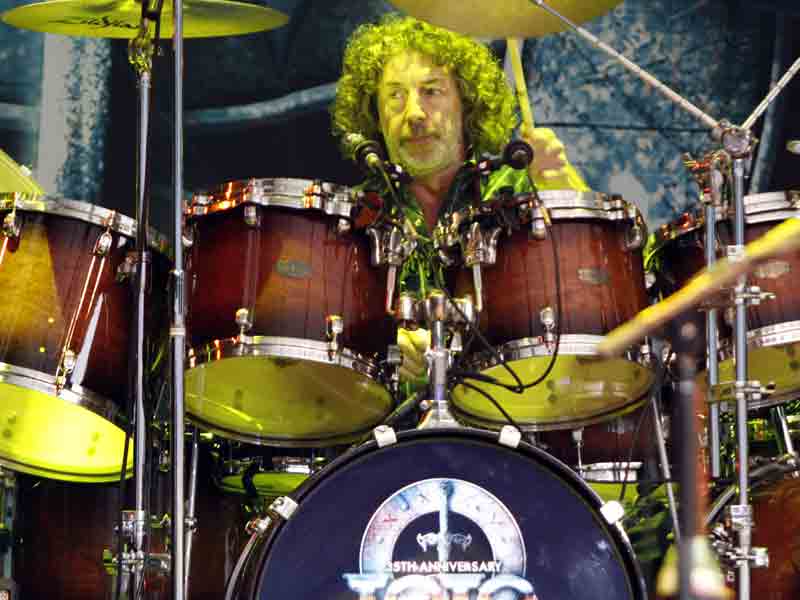
Toto comes calling
The list of Simon’s glittering gigs goes on and on. But in 1992 he was invited to join Toto, following the untimely death of Jeff Porcaro.
Simon stayed with the band for 21 years. “I retired at the end of last year. The band had gone through a lot of changes and we basically broke up in 2008 and then Luke [Steve Lukather, guitar] and Dave [Paich, keyboards] wanted to put it back together, just do a couple of tours, it was not really meant to continue.
"So they called me and it was okay, but it was very different and then there was a big change of management and all sorts of stuff going on and for me, quite simply, it wasn’t enjoyable anymore. It ceased to be a challenge and there were some clashes coming up with Hiromi and my band and I felt that I have said all I can say in this band, I need to move on. I know they were sad about it, but they understood.
"Any band that has been together a long time, it’s always difficult"
"Any band that has been together a long time, it’s always difficult. We don’t call each other every day [laughs] but we are still fine. Luke came to see my band when we played Catalina’s in LA and he loved it. There’s a mutual respect.”
Perhaps the highpoint of Simon’s Toto careerwas reached when he was asked by the band in 2006 to record their next album in his studio. “I engineered and co-produced Falling In Between. I think that was probably the definitive album with me in the band and I think it is excellent. It’s a huge responsibility to produce and engineer… and play!” he laughs incredulously. “It is stressful, but it’s something I do and I am used to doing. But with five other people in the room and having to look after sonically what is going on… yeah, it was exhausting.”
I wonder if Simon feels it is generally advisable for all drummers to have other strings to their bow? “It really depends on the individual,” is his feeling. “Some people have a waiting hidden talent. But in any band you rarely have four people that just play their instrument. You get one who is the songwriter, one who is a bit of an artist and works on the covers, one who is business-savvy. After a few years they tend to find their natural positions, their niche.
"With Toto, when I joined I had no idea what everybody did and they probably had no idea that I was engineering and producing"
"Like me with Toto, when I joined I had no idea what everybody did and they probably had no idea that I was engineering and producing. They kind of figured that out when we started to record because I was bringing in my computer and setting up the tempos and clicks and samples. And then I would listen to stuff and go, guys, how about if…? And they’d turn round and go, actually that’s a really good idea!
"Slowly they realised, and eventually they entrusted the engineering and production to me. I would guide them in terms of how we were gonna do the record, what studio, what format, analogue or digital, and they would listen and I would work with [top producer] Elliott Scheiner.”
While we’re on the subject of producing again, let’s pick out one more of his collaborations. I’m intrigued by the image of Simon working with the ferociously gifted Aussie drummer Virgil Donati, who asked Simon to produce his Planet X prog-metal-instrumental project (with ex-Dream Theater’s Derek Sherinian) MoonBabies (2002). Simon reveals, “It’s funny, when we were recording, most of the time I had no idea what the heck Virgil was doing or how he was doing it! Amazing! We had a lot of fun and I think it was a very good pairing. I really hope to do it again sometime.”
But returning to the new album, Protocol II, as a drummer foremost, do Simon’s tunes often evolve from a rhythmic idea or drum groove?
“Not usually, no. The best ones usually come from a melody. I have a keyboard that goes into ProTools or Logic and that way I can select sounds. I’ve simplified it over the years so I usually start with a piano or Fender Rhodes, or a sampled guitar sound. I don’t really think much about the drums. 0
"I wait till part of the composition is there and then I might put the drum kit in and play along to see how it’s sitting, because when you write in a sequencer it can play anything perfectly in any tempo. But the human does not! The human needs to play in the right tempo for the song, so that tells me instantly that, oops, the tempo is a bit too slow or too fast for that song.”
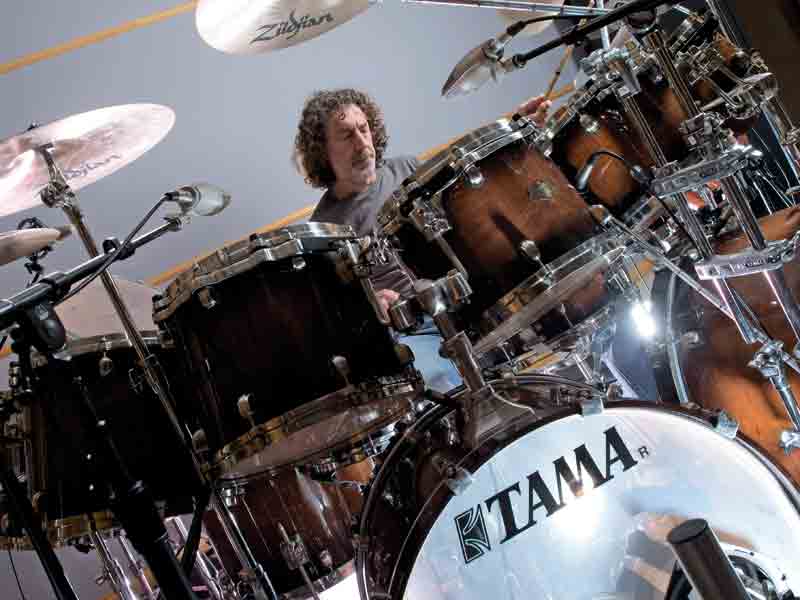
Following Protocol
Rest assured, Protocol II has umpteen passages with jaw-dropping drums, but always in the context of the music - there are no completely solitary drum solos.
“I don’t see the point of doing unaccompanied solo drums on a record,“ Simon reasons. “Live is a whole different thing. And when I do that, it’s totally improvised. But for a record I don’t want the guys standing there with folded arms. I see it as a unit, so just as the others take a lead solo, then I take a solo but the band doesn’t stop. It’s more interesting to have something going on instead of just completely solo drums.”
“I don’t see the point of doing unaccompanied solo drums on a record,“ Simon reasons. “Live is a whole different thing"
Nevertheless, the track ‘Octopia’ is a cool piece for featured percussion, with Simon’s trademark Tama Octobans lending an almost electro-riffsound to the composition. “Weingart said to me,are you gonna do a solo on this record? I said no,so then he said, ‘How about we do a duet, something a bit more organised and orchestrated?’ So that is what we did.
"We set up with just the two of us and we spent most of the day trying to figure something out and it didn’t really happen. Thenwe went back to the original idea and it suddenly came together. So it is the ‘drum solo’ in a way,but a little more interesting.”
And talking of duets, in 2010 Simon performeda series of duets with Gavin Harrison for theGuitar Center Drum-Off in LA (there are videoson YouTube that are well worth checking out). Arguably the two most celebrated modern drummers the UK has produced, vibing off one another. Gavin is the UK drummer who has made the biggest impact in the USA since Simon interms of poll-winning talent.
Simon says, “I absolutely loved working with Gavin. He is a very creative player and we had similar approaches to putting those compositions together. We actually have quite a connection as his dad used to play in my dad’s band when I was the drummer! He was a great trumpet player and I was always excited when I heard that he was on the gig.
"I met Gavin when he was really young – maybe eight or so – as his father asked me to come over to hear him play. It was many years until we met again. It was also a privilege to introduce him at the Modern Drummer Festival in 2008.”
Incidentally, Gavin told Rhythm last year, “Simon and I, knowing we had to do a 20-minute duet, decided we would do something the opposite of what the (competing) kids were obviously going to do and we decided to play the most musical drum duet we could think of. We divided it into four five-minute sections and we wrote and rehearsed it in Simon’s studio in two days.
"We had a plan – let’s do this for a bit and then I’ll give you a nod and we’ll go into that and do that for a bit. It was quite hard to remember and I had a lot of notes on the floor about what vibe we were going to do.
"There were times when Simon would play a melodic ostinato round his toms because he has so many of them and I would solo over that, and then vice versa. That was a lot of fun and in fact I think it is one of the best things I ever did.”
Gavin mentions Simon’s multiple toms. Over the years Simon has sometimes had to fight to get his extensive kit accepted. “That is my instrument,” he argues. “That is how I look at it, and it doesn’t seem right unless it is all there. But there are times when I play a smaller kit, especially when I have my straight-ahead band or if I play locally at the Baked Potato [LA club] or something.”
Which brings us to Hiromi. Simon brings his full kit, with twin 24" bass drums, to the Trio Project, unusual to say the least for an acoustic piano trio. Was there ever a question about using it? “In my mind it was a big question,” he admits, “because I didn’t see how an acoustic piano was gonna work unless you put a load of mics on it and screen it off. But that was Hiromi’s vision.
"Being in the studio is one thing because you can isolate everything, but once we started playing live I was dubious: I don’t know if this is gonna work. But interestingly it gave me a whole different way of playing. I had to really dig deep and start playing a lot quieter, which in turn made me have a lot more dynamics. What I didn’t realise is that when she is playing a nine-foot grand piano she is incredibly loud, she is a really powerful player. So we have the lid open with four mics and no screen and it works amazingly.
"I had to really dig deep and start playing a lot quieter, which in turn made me have a lot more dynamics"
“Depending on what kind of place we are playing though it can get a little difficult. Like in London we played the Cadogan Hall and it is such a live room that the drums were ricocheting. It was a little unpleasant and I had to be really careful with my level and it is super challenging. But given the right acoustics, which most of the halls we play in have, it’s amazing, it works beautifully and it has really opened up a lot of things for me – a great learning experience.”
Hiromi plays a powerhouse mixture of classical, jazz and prog, which in fact suits Simon’s fusion-style kit (and playing style) rather than a traditional small four-piece. Still, it can only work because the piano is miked up as Simon describes. But then a guitar-led trio is something of an aural illusion too in that the guitar also has to be amplified to compete when the drums get loud.
“The difference is that guitar occupies a lot of space and is not so transient, so it always sounds full. The one thing I noticed when I started to play with Hiromi and Anthony is it sounded thin to me. It took me a while to get used to – wow, that is why the drums appear so loud, because there is nothing masking them anymore. But now I am used to it and have figured out how to approach it.” As an afterthought Simon appeals, “Let’s not forget, the music is incredibly hard to play. Very challenging!”
No argument there. And just as when he was asked to join Toto ahead of a dozen more obvious American names, so Simon teaming up with Hiromi was a surprise. Makes yer proud to be British!
He recalls: “I got a call out of the blue from her management. Would you come and play on Hiromi’s next record? And I went wow! Er… okay! I had been watching some YouTube footage of her playing with Chick Corea, but I was still very surprised they would call me. I asked them if they knew what I do? Oh yeah, she is very aware of your playing. And you have played a lot with Anthony Jackson… Ah, yes, we go way back. And so it just kind of happened.
“[The first day] was in a little rehearsal room called Euphoria in New York City. I had a small kit just to run through some of the music. That was tricky because there was just a tiny piano and it was hard to hear properly. But it gave an idea of what was to come and we got through. Basically she writes the music and has lead charts and it is up to me how I play it.”
With Hiromi’s pieces being so complex I wonder how Simon’s reading is these days. “Not as great as it should be,” he concedes. “It’s like speaking a language: if you learn Spanish and you don’t speak it for a few years it’s gonna be a bit rough – and it’s the same reading music. But the thing is [laughing], as a wily old fox, even if you can’t read it, your experience gets you through and you just bumble your way and make it to the end. The next pass you correct things. In the end you are playing music, and as long as you use all your ears that is the most important thing. You are really playing by ear all the time and just using the music as a guide.”
But let’s not be naïve, no one could walk into The Trio Project unless they were deeply conversant with and capable around jazz. After all those years in Toto and playing fusion, people forget that Simon was steeped in jazz from a very young age. He has released previous albums of solely acoustic jazz with pianist Jeff Babko (Vantage Point, 2007) and there’s his tribute to Tony Williams (Another Lifetime, 1997), but still he had to brush up his jazz chops.
“Absolutely, yeah, I was always a huge fan of Tony. As you are forming your playing you basically beg, borrow and steal from all these great players and slowly it becomes yours and you use it however you want to, it is all vocabulary. There are certain places I might channel a bit of Tony or Elvin and when we are playing straight-ahead sections I actually channel a bit more Lenny White. He has a beautiful touch and is very light and that really works in that scenario – especially when you are playing a 24" bass drum!
" I even swap sticks for different songs.If playing a live hall like the Cadogan Hall I use my Will Kennedy sticks with the small bead which is a little sweeter on the cymbals. Because my choice of cymbals is a jazz style anyway, I can use the same ones [as usual]. I use very light cymbals, all of them are pretty thin. So it works beautifully with the small acorn bead. I do add another ride, usually a K Zildjian or Constantinople.”
And is there the temptation to revert to right-hand lead in the more traditional jazz situations? “Sometimes – well, definitely. I put it [ride cymbal] on the right side and play it more straight-ahead right-handed because I grew up playing that way. When I swapped to left handed I was playing rock and fusion. I never played that much swing, that came more in later years, especially the touch and feel for that and it is something you have to continuously do. It is like double bass drums – if you don’t play music that uses double bass drums you get rusty. Or like playing quietly, if you don’t do that much it is hard. All these different languages and styles, it’s hard to keep up with everything.”
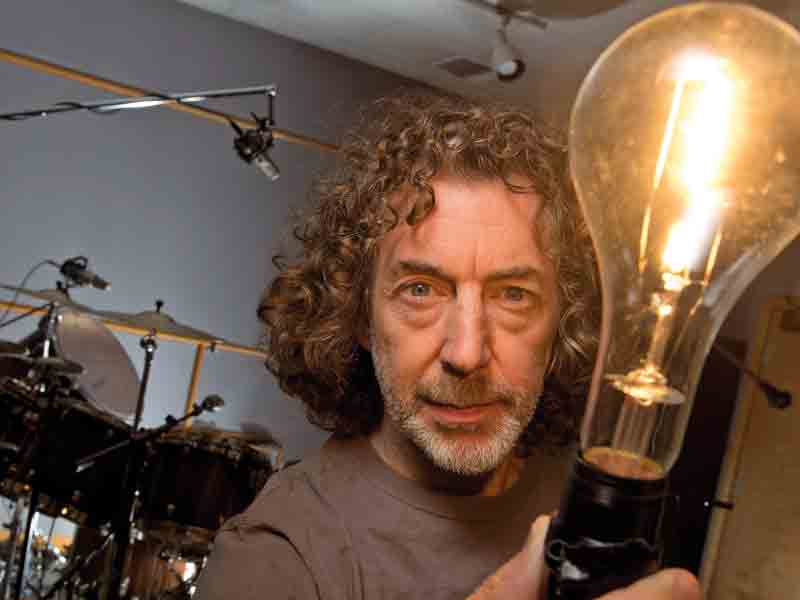
Keeping Up
But keep up Simon does. Including checking out the bright new drummers on the jazz scene. “There are some great players. We’ve just been out on tour and Greg Hutchinson is a great player – doing some different stuff, amazing. Eric Harland plays great.
"And there’s a young guy called Justin Brown who plays with [pianist] Gerald Clayton. These are actually the guys I have been listening to as we have been doing jazz festivals and they have been playing the same dates. So I’ve been checking out the younger up-and-coming players and these three are exceptional.”
As we speak Simon has dates lined up with his own Protocol band. “We are doing Europe and then next year we are going to make another record. We’ve already been to Japan and hopefully we’ll do some Far East shows, and concentrate on the States and come to England too. I’m trying to get into Ronnie Scott’s for a few days – I have actually never played there…
"Music should always be as though you are playing it for the first time”
“Every show, every time you sit down and play the drums or play music you are learning something. My thing is to always be creative and musical and be listening to what is going on and try not to get into repetition.
"What I notice with a lot of bands – they rehearse and they go out and start playing and usually those first shows are good because everyone is aware and listening and about 20 shows down the road it is amazing how many people shut off their ears and forget to listen because they are not even looking at each other. To me that is not the way to play music.
"Music should always be as though you are playing it for the first time.”
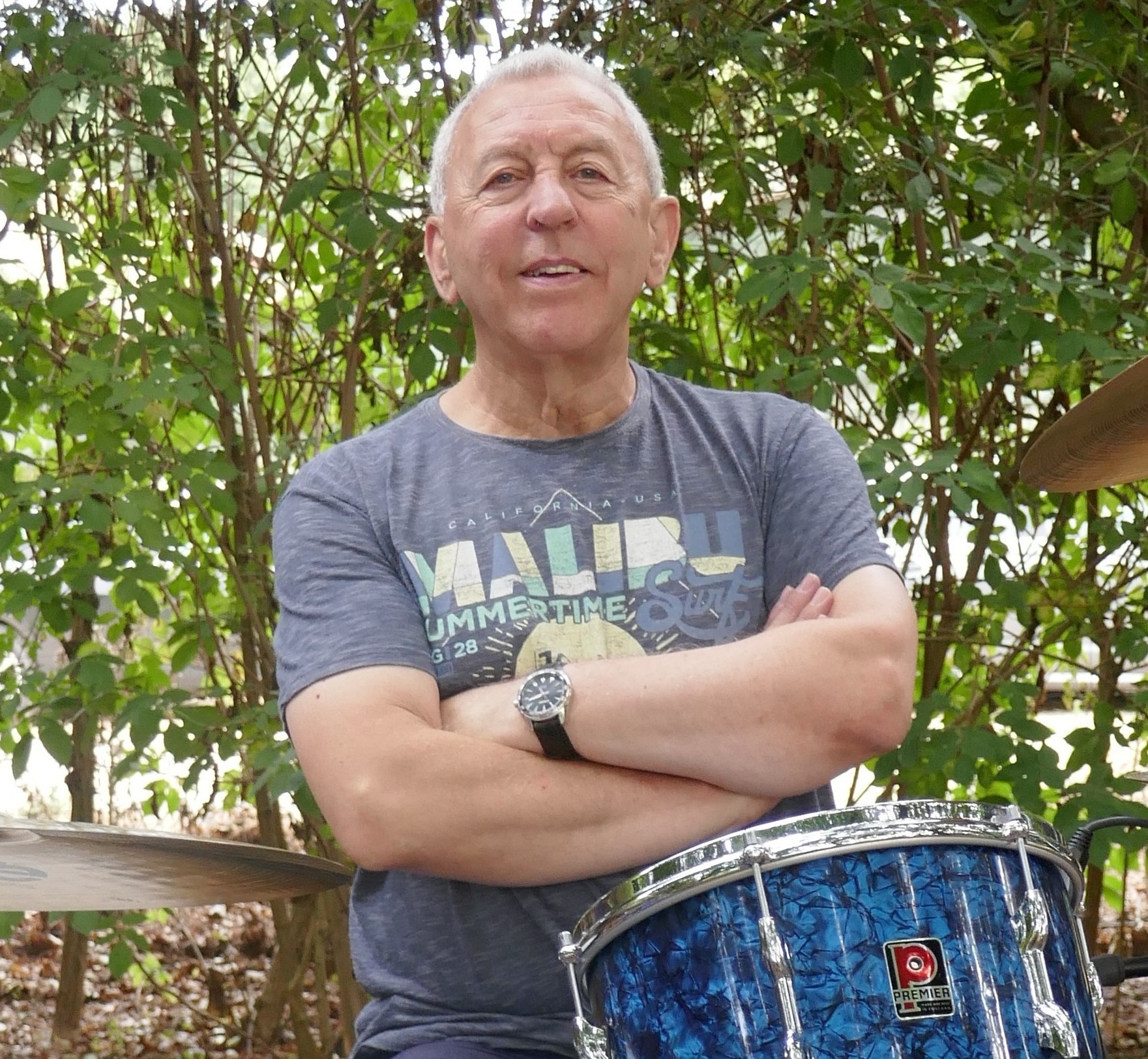
Geoff Nicholls is a musician, journalist, author and lecturer based in London. He co-wrote, co-presented and played drums on both series of ‘Rockschool’ for BBC2 in the 1980s. Before that he was a member of original bands signed by Decca, RCA, EMI and more. ‘Rockschool’ led to a parallel career writing articles for many publications, from the Guardian to Mojo, but most notably Rhythm magazine, for which he was the longest serving and most diverse contributor.